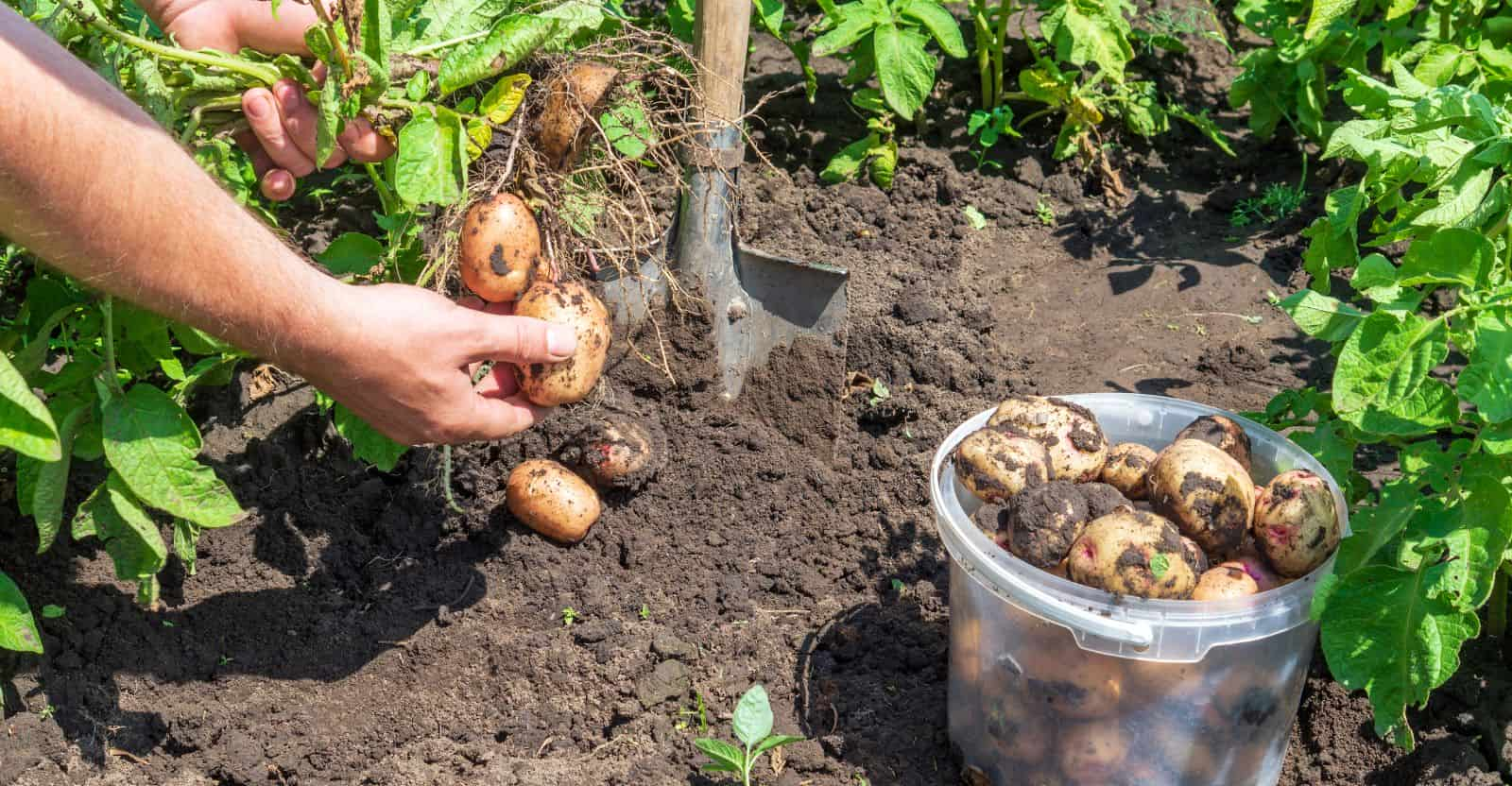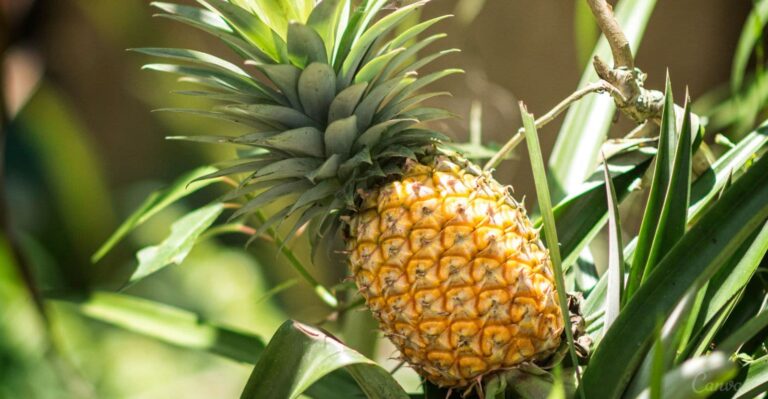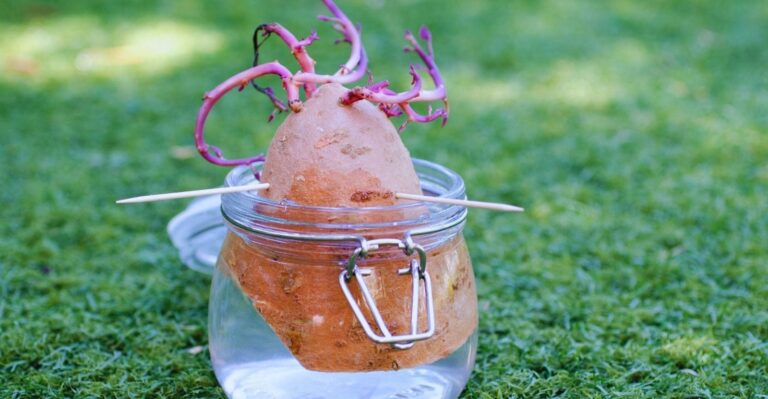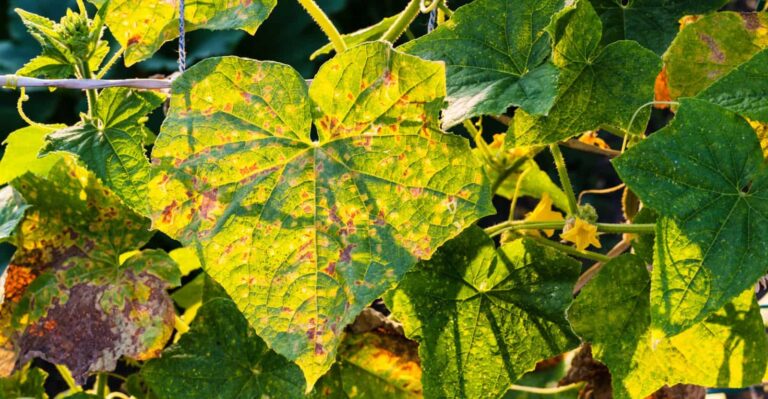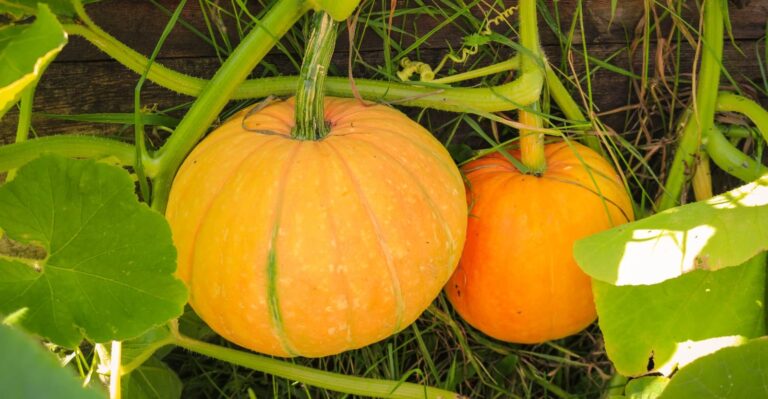Amazon has put together some great Home Gift Deals – save money and get your shopping done at the comfort of your home! Click here to see deals on Amazon
Last season, I decided to plant potatoes in my backyard, and everything went nice till it came time to harvest potatoes.
I didn’t know when to harvest potatoes, so I visited my local garden store to talk to the product expert. I got some excellent information, and I decided to share it here for all of you.
One of the common problems which many beginner potato growers run into is that the potato grows under the ground. It makes it hard to tell when it is ready to harvest.
But potato gives the sign itself that it is prepared to be collected. The thing you need to know is where to look for it.
Let’s start by knowing the types of potatoes
The harvesting time of potatoes depends on the type of potatoes you have planted. Most commonly, the potatoes are ready to be harvested when they start flowering. Any time between the flowering of the potato plant to when the foliage starts turning yellow is the right time to harvest.
Types of Potatoes
There are various types of potatoes, and these are primarily classified based on the time they grow and become ready to harvest.
Based on the growing time, potatoes can be classified into three main types:
Early – Season Potatoes
These are planted early as they grow fast and become ready to harvest in 75 to 80 days. The typical early season potatoes are Lady Christl, Arran Pilot, and Red Duke of York.
These potato plants are planted by the end of March and are ready to harvest by the end of June to early July.
Mid – Season Potatoes
These are planted in mid-season and are harvested from 95 to 115 days. Some standard mid-season potatoes are Nicola, Kestrel, Maris Peer, and Jazzy.
These are planted in the mid of April, and the potato becomes ready to harvest in July to August.

Late – Season Potatoes
These are planted in the late season and need a longer growing period. The late-season potatoes are to be harvested after 120 to 140 days.
Some late-season potatoes are Pink Fir Apple, Purple Majesty, and King Edward.
The early season and mid-season potatoes are also referred to as New potatoes. This is due to lower growth time. These are dug before the potato plants reach maturity. But it means the tubers are still small.
Do you know that potatoes are perennial which are grown as an annual? Depending on the variety of potatoes, it comes in various colors such as brown, yellow, tan, red, and purple. Potatoes yield is quite high as each plant grows about 5 to 10 potatoes.
The late-season potatoes are referred to as storage potatoes. The plant is harvested when the potato reaches its full maturity at the end of the growing season. The mature potatoes are quite big in size and are ready to be stored to be used later.
When To Harvest Potatoes
Early and Mid Season Potatoes (New Potatoes)
You can start harvesting potatoes when the plant starts flowering. The flowering is a good indicator that the tuber formation began in the ground.
Potato takes time to grow and reach maturity. If you want smaller potatoes, then you can harvest any time after the flowering. Keep in mind that these smaller new potatoes are not very good for storage and have to be cooked soon.
You do not have to pluck the whole plant to get your potatoes. You can move the soil bit aside and remove a few potatoes. As long as you take care of the plant, the remaining tuber will continue to grow.
Late Season Potatoes (Storage Potatoes)
The late-season potatoes are matured potatoes and are ready to be harvested when the foliage turns yellow.
You can also wait longer till all the foliage becomes dry and fall off and then dig out the potato. But be aware that sometimes very late harvesting of potatoes can result in potatoes start getting rotten.
What season are potatoes harvested?
The potato planting time determines the season the potato is to be harvested. Early season potatoes are planted by the end of March.
These plants are then ready to harvest in late June to July. The mid-season potatoes are prepared to be harvested by late July to August. The Late season mature potatoes are to be harvested from September to October.
How long can you leave potatoes in the ground?
You can leave potatoes in the garden till it matures completely and the foliage dries off. Leaving it after that in the field will result in potatoes starting to get rotten.
The late-season potatoes can remain in the ground for two to three weeks after the foliage has died off at the end of the growing season.
You should not water the potato when the foliage gets yellow or dried off. Watering the potato may result in it rotting.
Can you dig potatoes before they have flowered?
You can dig the plant but don’t expect it to have any meaningful size of potato before they have flowered.
It is ideal to wait a while till you see the plant start flowering. Harvesting potatoes too early will result in no potatoes.
Can you harvest potatoes too early?
You can harvest potatoes when it flowers to the time when the foliage turns yellow and dry off. If you plan to cook potato right away, then you can collect them when it is still small.
But if you are planning to store it, then you should wait till it grows fully and gets thicker skin. Potatoes are tubers, and you want them to grow as much as they can so you get the full flavor of the potato.
Can potatoes survive in winter?
Potatoes are not planted very deep in the ground. A typical potato is planted around 1 to 3 inches under the ground. This is good enough to protect potatoes from light frost when the temperature is between 30 to 33 degrees Fahrenheit.
But any lower temperature from 25 to 29-degree Fahrenheit will be too much for it to take and may damage the plant. Depending on the elevation of the potato planter, it can last longer or shorter.
Potatoes planted at a higher altitude such as at the top slope have more warm weather. This results in higher elevation potatoes to last a bit longer than potatoes planted at the lower elevation.
How To Harvest Potatoes
You can harvest potatoes when the flower starts blooming or when the top stem completely dies. You have to be careful when harvesting potatoes as you will be digging and removing the soil to get the potato out.
You can harvest potatoes by digging up with a shovel or a garden fork. Don’t dig right underneath the potato plant but go around the plant to not damage the tubers in the process.
If a potato plant has a strong green stem, then you can pull it up to unearth attached potatoes. Then move your hands around the soil to pick any fallen potato. The potatoes inside the ground spread around.
Start the potato harvesting by digging 8 to 10 inches away from the stem. Then dig at least 8 to 10 inches deep to be safe not to damage the potato. Be aware of the type of potatoes you are harvesting as some of the potatoes grow shallow and close to the stem, while others will spread throughout.
If you don’t know how deep and spread the potatoes are then dig up only the first plant. It will help you determine what to expect with the other plants of that variety.
Digging in a dry weather condition is preferable as it makes it easier to separate potatoes from the bare soil. In a warm, excellent weather condition, leave the dugout potato in the field, unwashed for 2 to 3 days. This will help with the curing of potatoes, which will make them easier to store.
It is inevitable that during the harvesting process, some of the potatoes will get damaged during the digging. You should keep damaged potatoes away. These soiled potatoes should be cooked earlier as these are not suitable for storing.
There may be the case that your potato plant may look healthy and flowered, but when you dig it up, there may be no potatoes. This happens when the garden soil has excess nitrogen in it. This occurs when you over-fertilize the potato garden.
Another reason for no potato may be due to rocky soil which causes tubers to get deformed. If there is no problem with the ground and you still do not have any potatoes growing, then it may be that you started harvesting too early.
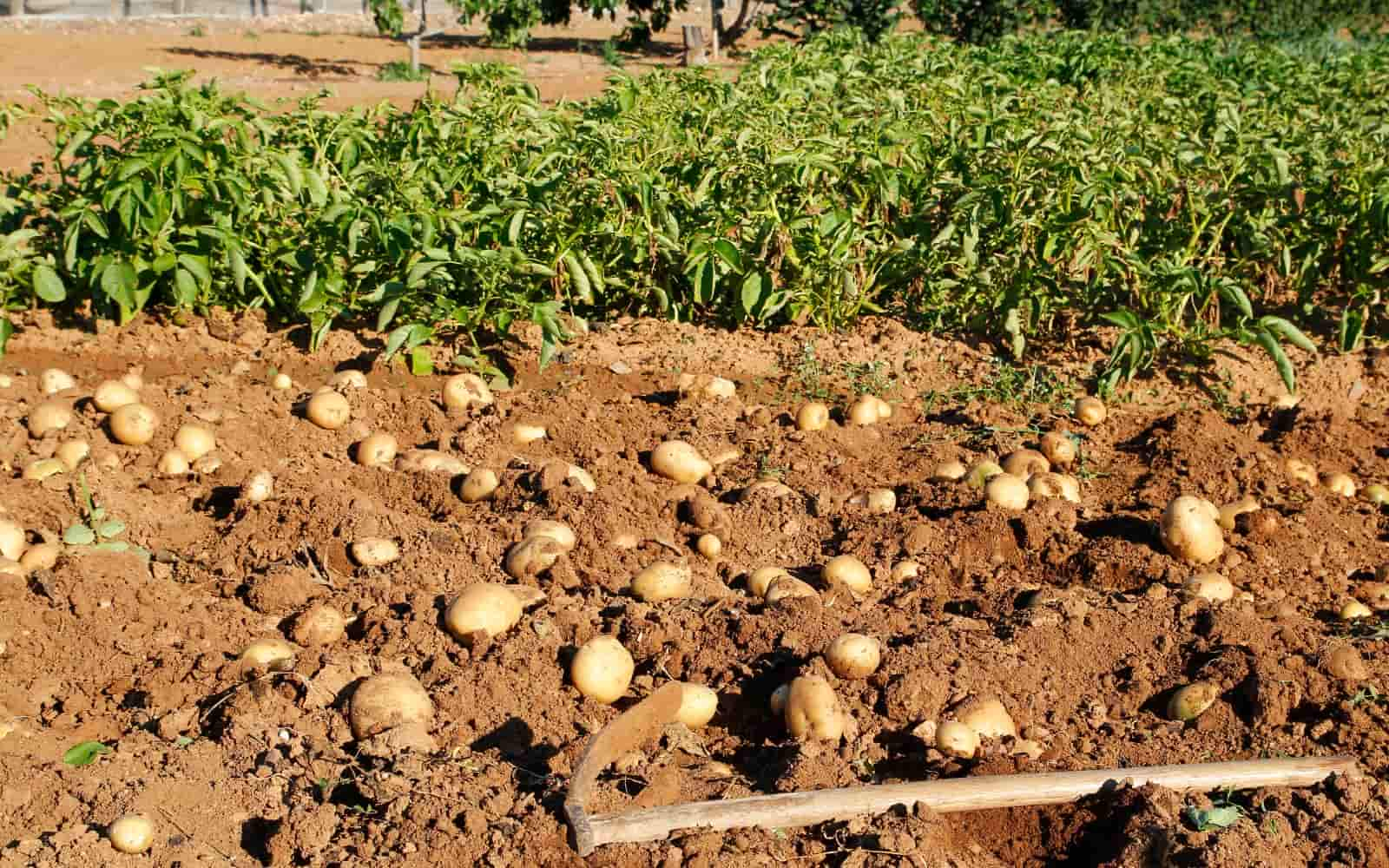
Potato Harvesting Tips:
Here are some harvesting tips for digging out potatoes without damaging them.
- Harvesting tool: You should use a three or four-pronged digging fork. It helps to move the soil around without damaging the potatoes.
- Use more hand: To be safe that you do not damage potatoes during digging, use your hand more than the digging tool. Use digging tool only to loosen the soil and once the land gets loose, move the ground around and feel for potatoes and pick it as you find it.
- Harvesting process: Start the digging bit further away from the plant and work your way close to the base of the plant.
- Keep it dry: Harvest on a dry day as it makes the ground to move easier.
- Consume: Eat the damaged or bruised potato quickly. These potatoes have a low shelf life and will rot quickly.
How To Store Potatoes
Potatoes need to store in a dark, cold, and high humidity area. Do not store these where it gets exposed to direct sunlight or where it gets the risk of freezing.
A frozen stored potato falls apart once they are thawed and become inedible. An ideal temperature to store potatoes is between 33 to 50-degrees Fahrenheit.
Store it in such a place where potatoes do not get natural or artificial lights. Many homeowners store potatoes in the root cellar, a garage, or in a slightly heated shed.
Early or mid-season potatoes are not very suitable for long-term storage. These are the best to be consumed quickly, and you should not plant or store them for more than a week.
If you cannot eat it all, then you can only harvest the portion of what you need and leave the rest on the plant to continue to grow. These early or mid-season potatoes have fragile skin, which makes them unsuitable for long-term storage.
The late-season potatoes are suitable for long-term storage. These potatoes have thick skin which allows them to retain inside moisture and you can store it for a long duration. If you do not have enough storage, then you can leave these storage potatoes in the field but don’t leave them for too long.
Once the top foliage is dead and dry, stop watering the potato plant as it will rot the tubers. Make a plan to remove the potato from the ground as the dead foliage above the ground may attract pests and diseases which could spoil the potato.
Potatoes once dug from the ground should be cleaned with a soft, dry brush or cloth. Don’t use water to clean these if you are planning to store these potatoes.
Before storing potatoes, you have to cure them by keeping them between 45 to 60-degree Fahrenheit for a couple of weeks. You will know the potato has become cured when the outer skin of the potato gets dry and hard.
Potatoes, when get exposed to sunlight during growing, will turn green. These green potatoes are not safe to eat as it contains poisonous compound and should be discarded.
Storing temperature matters a lot to improve the shelf life of the potato. If the temperature becomes too warm, then it will cause potatoes to begin sprouting, and also damp and cold temperatures will rot the tuber. So, try to control the storing temperature.
Do not keep potatoes with apples as it releases the ethylene gas which rots the potato. Inspect potatoes before storing for any cut or bruises as they may spoil quickly and will make other potatoes rot.
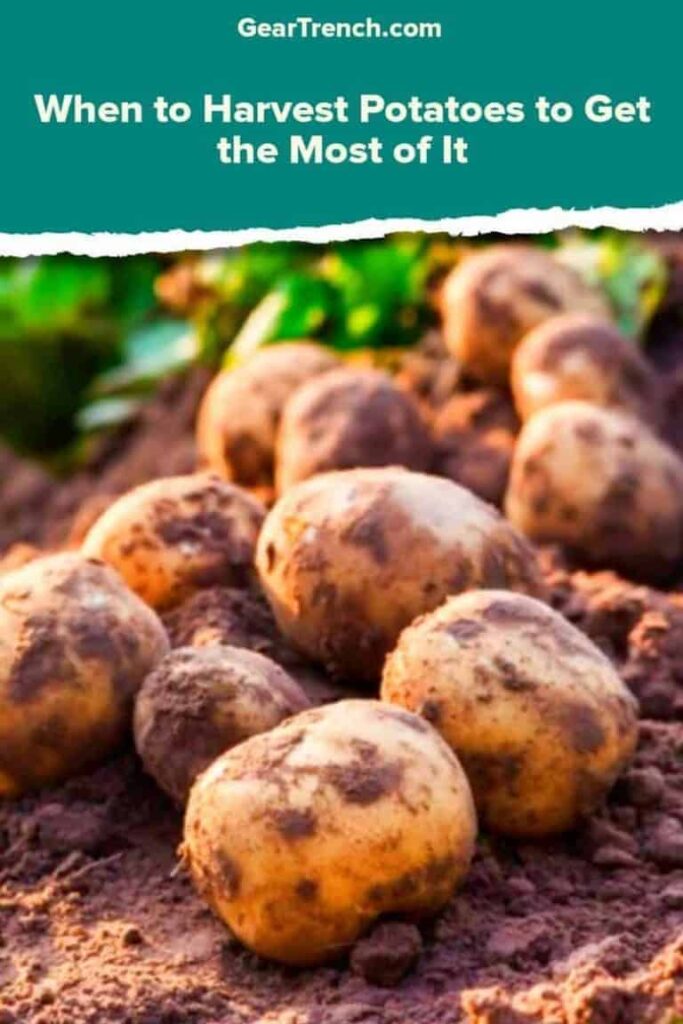
Don’t forget to share this post

